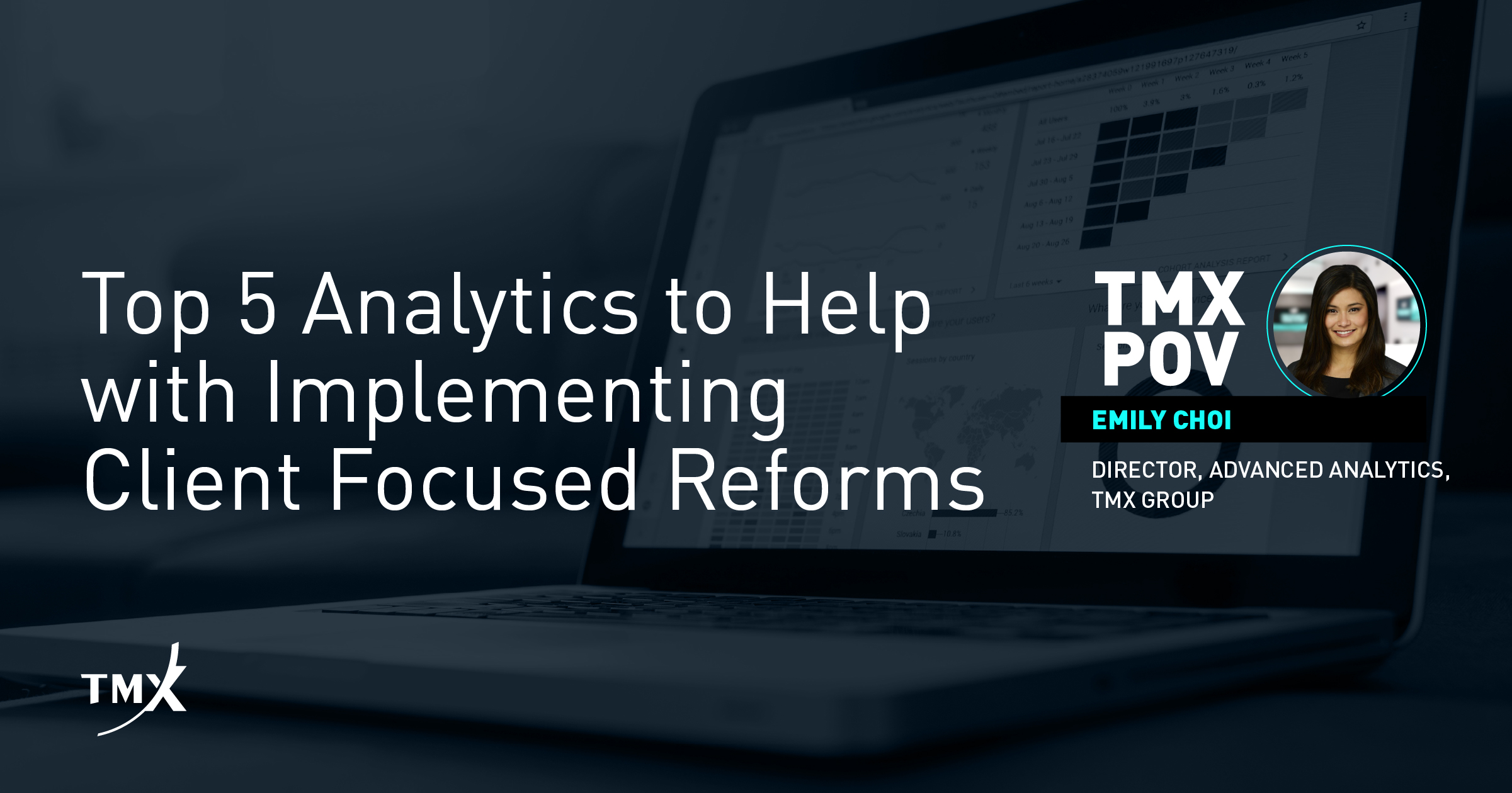TMX POV - Top 5 Analytics to help with Implementing Client Focused Reforms

Every few years, there are industry-altering changes that cause wide-scale shifts in how financial services firms operate. Currently, the Canadian Securities Administrators' have introduced Client Focused Reforms, also known as CFR, which impact all registered broker dealers and wealth management businesses - basically anyone providing investment advice - across the country.
Client Focused Reforms are built on the concept that the interests of the client should come first in the client-registrant relationship. For those who aren't familiar with the reforms, Strikeman Elliott provides an excellent overview of the amendments to NI 31-103 here. They encompass stricter requirements around KYP, KYC, suitability determination, relationship disclosure information (RDI), misleading communications, and compliance training requirements. All of these changes are aimed to provide broker dealers a deeper understanding of their clients; provide clients a deeper understanding of products they are purchasing, and to properly suited and communicated with care to end clients.
While CFR includes amendments to rules focusing on the full advisory life cycle, including account appropriatenessand exceptions to account appropriateness, the focus here is specifically on the KYP and Suitability rules which is where the need for high quality data and analytics on investment products comes into play.
According to FundData, there are over 100,000 mutual funds (including segregated funds) and over 850 ETF products in Canada. Investment products have evolved quite substantially over the past 10 years, with countless product innovations and replication strategies. We have yet to see analytics for mutual funds or ETFs evolve at the same pace. Many advisors and investment analysts continue to focus on the same analytics they used 10-15 years ago, however there are many more insightful analytics now available to consider. Here are the top 5 insights for firms and advisors seeking to expand their toolkits with the imminent implementation of CFR rules.
- Full Holdings Breakdowns - Mutual funds and ETFs hold a variety of other investment products, bonds or single stocks. As a result, typical research tools used for stocks do not show the full picture of performance or risk.. For example, if an advisor is assessing an equity ETF, they should consider the weighted average of all individual stocks within that ETF, and also understand if there are overlaps within holdings; an advisor holding single stocks and ETFs may accidentally be doubling their exposure to a single stock since its also held within the basket. Detailed analytics on the underlying portfolio is key before developing a comprehensive view on any investment portfolio.
- Risk Measures like Sharpe ratio & Sortino ratio - These widely-known but often misunderstood calculations seek to incorporate risk as an additional component in assessing performance (returns). The Sortino ratio is a variation of the better known Sharpe ratio that differentiates harmful volatility from total overall volatility by using the asset's standard deviation of negative portfolio returns—downside deviation—instead of the total standard deviation of portfolio returns. Both are extremely useful for advisors when considering a multitude of factors in their analysis of a product's suitability in relation to a specific client. Marginal Contribution to Risk (MCTR) is also a useful analytic as it measures the incremental risk that a particular holding contributes to the overall portfolio's risk, and in fact, hits a deflection point once a holding dominates within the portfolio since its risk is already substantially reflected.
- Liquidity and Cost to Trade - As many more advisors, including MFDA advisors, incorporate ETFs into their portfolios, there may be common questions and misunderstandings around ETF bid/ask spreads and ETF liquidity. ETFs trade at a bid or ask price, while mutual funds which trade at a straightforward single daily NAV price. Liquidity risk is therefore measured in multiple ways:most often, the bid/ask spread is used alongside average daily volume(ADV), but other factors like a weighted average of the underlying liquidity of each holding within a mutual fund or ETF can provide greater accuracy. Others look at additional metrics like the average bid or offer volume, and volume advertised at subsequent price levels beyond the top of book or best bid or offer. To truly measure the liquidity risk of an investment, multiple data points and analytics are required beyond average daily volume, including spreads, average bid/offer volume depth, and the resiliency of the quote.
- ESG Factors - Sustainable investing is gaining momentum and not only for younger generations. Understanding client preferences around investing to address climate change, diversity in management and other social justice issues may not be strictly mandated by regulation but is considered by some as an important element of knowing your client. Analytics are now available to help break down ETFs and Mutual Funds, in addition to single securities, to show ESG scores and warning flags such as oil, alcohol, gaming and tobacco that may be associated with the security or investment product.
- Portfolio-level Analytics - Lastly, any investment product or security should be analyzed in the context of how it fits within the client's overall portfolio. Sometimes the goal may be to improve performance by increasing exposure to a specific sector, geography or asset class, and other times the goal may be to reduce risk or volatility while maintaining as high performance as possible. The cost of portfolio management tools that run these impact calculations has decreased dramatically in recent years, and some tools go one step further to suggest portfolio improvements or optimizations using artificial intelligence.
It is increasingly difficult for dealers and wealth managers to prove tangible ways that their firms are meeting CFR and KYC/KYP requirements. In Canada, securities regulation has always been principle-based, which allows some room for firms' own interpretations and application to their unique business needs. We believe that this is a fair and thoughtful position since there is no one-size-fits-all approach in investment management and advice. There are, however, commonalities that most firms would agree are foundational to their businesses such as providing the required data, analytics and tools to their staff to perform their advisory roles effectively. In the past, some firms opted for basic and essential analytics while others required a more robust offering with all the bells and whistles. With CFR, we see that there is a trend toward the bells and whistles now becoming table stakes to play.
TMX Logicly is one of several tools that can provide solutions for increased data and analytics required by CFR. TMX Logicly embeds data and analytics along daily workflows and its AI-based Portfolio Coach tool provides a clear way for advisors to perform daily portfolio management tasks and compliance checks. For more information on this product, please visit www.tmx.com/logicly.
Copyright © 2021 TSX Inc. All rights reserved. Do not copy, distribute, sell or modify this document without TSX Inc.'s prior written consent. This information is provided for information purposes only. Neither TMX Group Limited nor any of its affiliated companies guarantees the completeness of the information contained in this publication, and we are not responsible for any errors or omissions in or your use of, or reliance on, the information. This publication is not intended to provide legal, accounting, tax, investment, financial or other advice and should not be relied upon for such advice. The information provided is not an invitation to purchase securities listed on Toronto Stock Exchange and/or TSX Venture Exchange. TMX Group and its affiliated companies do not endorse or recommend any securities referenced in this publication. TMX, the TMX design, The Future is Yours to See., and Voir le futur. Réaliser l'avenir. are the trademarks of TSX Inc. Logicly is the trademark of SigmaLogic Inc. and is used under license.


